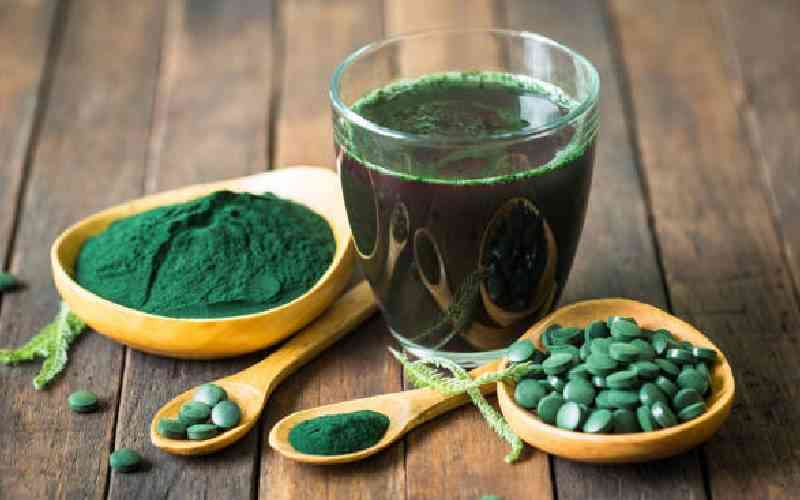
What is spirulina? How can I grow it? What are its nutritional value? Most of our readers have been asking.
Well today I will respond to these frequently asked questions about spirulina. Spirulina is 100 per cent natural and a highly nutritious micro salt water plant. This spiral shaped algae is a rich food source widely used as a dietary supplement.
Growing spirulina at home can be rewarding and exciting. It uses little water and energy, it can be grown both indoor and outdoor making it one of the most important enterprise that can improve your health and generate income.
Spirulina scores incredibly high on a nutritional scale: It’s rich in vitamins A and E, and the B-complex (in fact, this species is the highest non-animal source of B-12, a vitamin often difficult to obtain in a vegetarian diet), and has an impressive array of trace minerals.
Spirulina is also chock-full of protein, containing a whopping 65-70 per cent by dry weight (a per cent protein content of soybeans and 45 per cent of brewer’s yeast). Furthermore, the algae provide complete protein, containing all of the eight essential amino acids the body cannot manufacture.
Unlike other single-celled algae, Spirulina contains no cellulose in its cell walls, so the substance is easier to digest than the more fibrous forms. But perhaps the best news is that one needs to ingest only a small portion to receive benefits of this nutritional powerhouse.
Growing spirulina
There are a few important elements you need to consider before starting cultivation of spirulina. First is the light. Spirulina is like a plant and need light to survive (spirulina is actually a cyanobacteria but it needs the light for photosynthesis). Once you have the lighting figured out, the next step is to have the right temperature for your little cyanobacteria. Here again, nothing too complicated, spirulina will grow in a large range of temperature but there is a narrower range where it will yield the maximum production.
It is not possible to grow commercial Spirulina culture in a cold or temperate area. Spirulina needs consistent high temperature which helps its growth. Spirulina will not grow anywhere that has constant low temperature (under 25 degrees). Under 20c degrees spirulina will stop reproducing and die in a short time.
The next step to grow spirulina at home is to make sure that your tank or pond is correctly agitated/aerated so that all the spirulina filaments have access to light and CO2. The final, and also one of the most important, step is to make sure you have the right culture medium and the right water for optimum growth. Spirulina grows in alkaline saline water.
Because spirulina easily absorbs nutrients from water, if the water contains pollution or heavy metals, these will be highly concentrated in the spirulina cell. If this happens, then this kind of spirulina is no longer suitable for human consumption.
It can be quite daunting in the beginning but after a few tries, it gets easier, and in no time you’ll be growing and eating fresh spirulina!
here is no question that freshly harvested, pressed biomass is superior to any other form of spirulina. However it will not keep more than a few days in the refrigerator, and no more than a few hours at room temperature.Adding 10 per cent salt is a way to extend these keeping times up to several months, but the appearance and taste of the product change: the blue pigment (phycocyanin) is liberated, the product becomes fluid and the taste is somewhat funny. Freezing is a convenient way to keep fresh spirulina for a long time. It also liberates the blue pigment, but it does not alter the taste. Drying is the only commercial way to store and distribute Spirulina. If suitably packaged and stored, dry spirulina is considered good for consumption up to five years.
Sun drying is the most popular among small producers, but requires a few precautions. Direct sun drying must be very quick, otherwise the chlorophyll will be destroyed and the dry product will appear blueish. Whatever the source of heat, the biomass to be dried must be thin enough to dry before it starts fermenting.
Stay informed. Subscribe to our newsletter
The total duration of the drying should preferably be two hours.
During the drying process the product must be protected against contaminations from dust and insects and should not be touched by hands.
The dry chips or rods are usually converted to powder by grinding to increase their apparent density. The best storage is in heat sealed, aluminised plastic bags.
Consumption
Eating spirulina is not quite as unappealing a culinary experience as you might expect. Luckily, you don’t have to consume spirulina in its original stringy, pasty form (which is 70 to 90 per cent water). After being harvested, the microscopic plants are nowadays dehydrated — by one of several simple methods — to produce a dark bluish green powder that has only a slight marine smell and taste.
The flavour is so mild it blends well with all kinds of seasonings and makes a tasty, nutritious addition to soups, dressings, dips, sauces, and juices. The powder can also be added to recipes for baked goods and sprinkled on salads, sandwich fillings, or casseroles.
When adding spirulina to liquids, it’s best to use a blender to insure thorough suspension of the powder. You should prepare only as much as you think you’ll use in one day, though, since the mixture is apt to ferment if it’s left sitting around too long.
Final word of caution: Be sure to store spirulina powder in a dark, dry place (and in a lightproof container) since the supplement’s rich vitamin content and deep colour are diminished by exposure to light and moisture. Spirulina is an ideal “survival” ration that can be stored up to seven years with practically no loss of its protein content. It provides a boost to joggers, athletes and tasters, and it can also be used as a supplemental ingredient in facial masks and infant formulas. The algae have even been mentioned as possible take-along food for travelers on long space missions.
In conclusion, the idea of eating seaweed has for a long time now been included among the standard jokes referring to natural food “fanatics” who’ll consume almost anything (no matter how unpalatable it may be) in pursuit of glowing health. Recent developments, however, indicate the jest may soon turn on its tellers! The fact is that spirulina could well become an increasingly familiar part of everyone’s diet.
- The writer is an expert/consultant on sustainable agriculture and agricultural solutions
 The Standard Group Plc is a
multi-media organization with investments in media platforms spanning newspaper
print operations, television, radio broadcasting, digital and online services. The
Standard Group is recognized as a leading multi-media house in Kenya with a key
influence in matters of national and international interest.
The Standard Group Plc is a
multi-media organization with investments in media platforms spanning newspaper
print operations, television, radio broadcasting, digital and online services. The
Standard Group is recognized as a leading multi-media house in Kenya with a key
influence in matters of national and international interest.
 The Standard Group Plc is a
multi-media organization with investments in media platforms spanning newspaper
print operations, television, radio broadcasting, digital and online services. The
Standard Group is recognized as a leading multi-media house in Kenya with a key
influence in matters of national and international interest.
The Standard Group Plc is a
multi-media organization with investments in media platforms spanning newspaper
print operations, television, radio broadcasting, digital and online services. The
Standard Group is recognized as a leading multi-media house in Kenya with a key
influence in matters of national and international interest.








